5 week Design Sprint - QLab Think Tank GmbH
Research | Ux/Ui | IA | Best practices
PROJECT DURATION
19th April- 25th May 2022
TEAM
5 members
Mentor: 2
PROJECT DURATION
UX/ UI Design, Visual design, Documentation,
Research Scholar
CLIENT
Stadtwerke Verden
DESIGN CHALLENGE
How can Stadtwerke Verden be positioned in the future to meet the climate goals and ensure a climate-neutral energy supply in Verden?
Overview
I got the opportunity to Participate in 5 week Design Sprint by QLab Think Tank GmbH, Bremen. They were approached by the City of Verden to develop the baseline research and ideas for achieving climate goals and supplying the citizens of the Verden region with reliable, affordable climate-neutral energy. Participants were from the field of Arts, Architecture, Power engineering, and Sustainability Governance. We researched and developed user-oriented sustainable ideas for new business models, services, and processes based on technologies and market requirements.
QLab is a Start-up based in Bremen, Germany that supports public utility companies and municipalities on their way to a climate-neutral and sustainable future to increase our cities’ quality of life.

Solution
Our sprint was primarily focused on new technologies, best practices that stadtwerke should adapt, and exciting energy-related start-ups. The design of a roadmap for the future process and the prototype for a one-stop shop, where customers of the municipal utilities may utilize all services and goods according to their needs, was one of the final solution. Other deliverables were prototype of a survey that Stadtwerke could conduct and strategies to network with different Stadtwerke and Start-ups.
Design thinking process
We used this Solution-based framework to come up with many ideas and potential solution as possible. This iterative process helped us to understand users, challenge assumptions, redefine problems and create innovative solutions to prototype and test.

EXPLORE & UNDERSTAND | Week 1
We dissected the Design Challenge, which helps us to create a common vision:
Who are the
Stakeholders?
What problems and challenges do they face?
Who might be their competitors?
What is climate-neutral energy supply?
What are their climate goals?
Identifying Stakeholders
Stakeholder mapping helped us to categorize different people in an organization. It enabled us to know whom to involve at what level, based on their level of influence.

Secondary research
Desktop research helped us explore the problem space and the scope of our project. Reading various articles and research papers on the web led us to identify the vital question and best practices in this field of study. We started our week by gathering prior research findings and other related information to our project.
Survey
Since it is essential to understand users' needs, desires, and priorities, a survey was conducted within our network to help us understand different behavior trends. The topics addressed in the survey were awareness and personal opinions, willingness to become more involved in change processes, and perception of the role of utility providers.
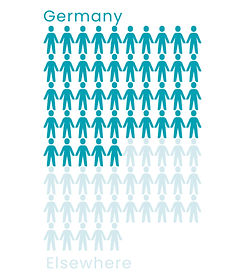
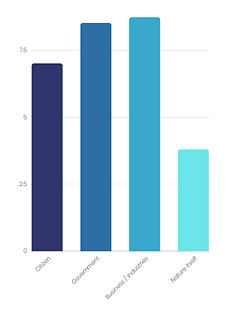
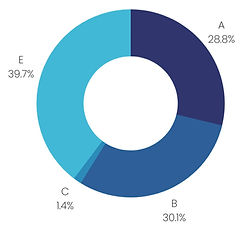
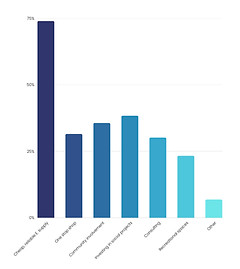
On the questions directly addressing energy supply topics, the results showed that nearly 40% of people did not know if the energy supplied came from renewable or not renewable sources (E). In contrast, 28.8% of the surveyed knew that it did not come from renewable sources (A); 30.1% knew that the energy provided comes from renewable sources (B), and the remaining 1.4% knew that either electricity or heating came from renewable sources (C).
Interviews-Insights
As a part of our exploration phase, we conducted 9 interviews with experts in the field of renewable energy, energy transition, and E-mobility. The interviews consisted of questions and discussions regarding organizational structures, government policies, research in the field of the energy transition, and solutions for stranded assets, among many more things.
-
The organizational structure of the utility providers needs to be changed to tackle the energy transition challenge.
-
Many facilities will become redundant, such as pipelines, house connections, meters, gas transfer stations, and remote control stations.
-
Electricity consumption will increase due to electric mobility and heat pumps.
-
Utility providers should be providing everything that the consumer can need.
-
Focus on locality - investing in projects in the area, local energy production, visibility, and involvement of local people.
-
Improving customer engagement has to be explored, and a consumer-centric business model must be developed.
-
Involving the community in the energy transition is of utmost importance.
-
Utility providers should look for opportunities to sell stranded assets like pipelines and metering devices to increase funds.
-
Utility providers can work in two ways: sell products and services or act as a platform for products and services.
-
Technologies like Agri PV are gaining recognition, and they support dual land use (Agriculture and energy production)
-
Community energy sharing will play an essential role in the energy transition.
-
People are scared of change and want highly reliable energy sources. That might be a hurdle during the energy transition.
Improving customer engagement and Involving the community in the energy transition is of utmost importance.
-Stella Oberle, Research Associate, Integrated energy infrastructures
SYNTHESIS | Week 2
Survey and interview data is the starting point that ensures an objective perspective in this process. These results allowed us to filter questions to understand trends and patterns from different groups. The actual needs of customers can be better understood from an empathetic perspective. We developed three Personas based on our research to understand and empathize with the user.

IDEATE | Week 3
We started to group several of these ideas based on our persona’s Goals and needs. We discussed on what can be done to assure the inclusion of citizens' needs in the further actions of the Stadtwerke and the City of Verden.
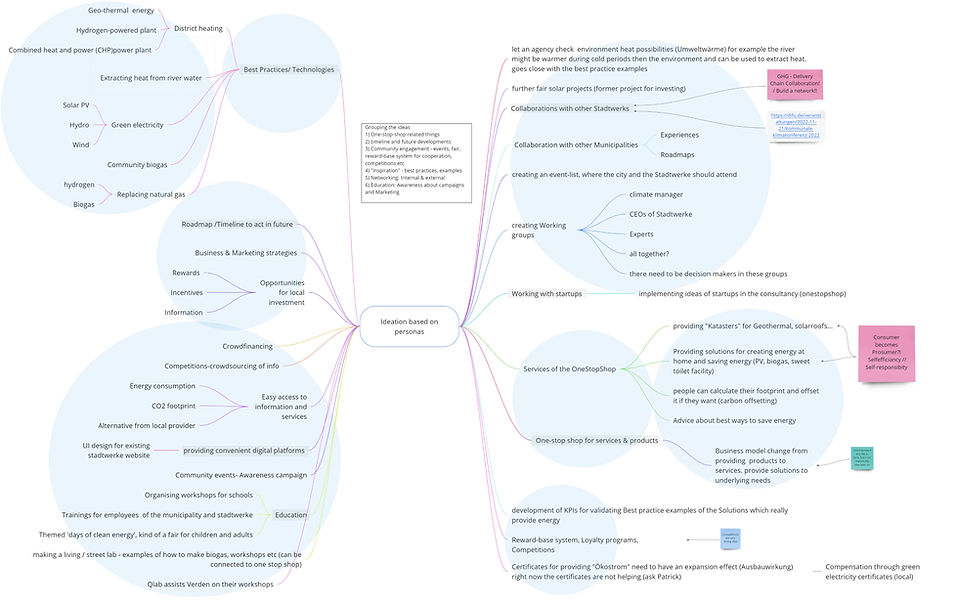
Key areas:
Timeline and
further
development
One-Stop
Shop
Community engagement
Networking
Education
BUILD ROADMAP | Week 4
The roadmap consists of two paths: the light blue, which stands for recommended actions, and the dark blue, for activities that we consider necessary to achieve the goals. Additionally, each task has a description leading to the corresponding text in the upcoming parts of the handbook.

Best Practices
We presented the selection of the so-called 'best practices.' Those are examples of companies, Stadtwerke, or municipalities that took actions towards achieving climate goals and were successful. We present this information ordered by the technologies and concepts mentioned in the roadmap, thus resulting from the research and needs of personas.


PROTOTYPE | Week 4
One-Stop-Shop- VERsorgt
One-Stop-Shop is a platform for citizens to access different products and services handled by Stadtwerke. It primarily includes tools to promote general awareness and increase social responsibility. This solution aims to increase consumption transparency and share advice on the best ways to save energy. This was suggested as one of the short-term and a mid-term solution for the citizens.

After onboarding, the user arrives on the home page, the main screen that summarizes the App's features like the latest news and products, a CO2 footprint calculator, and neighborhood comparison.
You can also look through different profiles in your city to learn about their climate-neutral vision and efforts. This tool promotes social responsibility and raises awareness by allowing users to see what others are doing to make the transition to a greener environment.
.jpg)
.jpg)
Sign in/ Sign up

Once the user clicks on the Events icon in the navigation bar, he can find several events near the city. Users can also read through different blogs and articles about the best practices and technologies developing in their country. Many existing services, like the online service portal, registration, and deregistration, can be accessed after clicking the consult button. Several other features, such as a CO2 footprint calculator and energy tracking, aim to promote consumer transparency and increase participation in climate goals.
%201.jpg)
Discover events
%201.jpg)
Latest news
%201.jpg)
Consulting
.jpg)
Discover events
.jpg)
Our Products
PROTOTYPE | Survey
As seen in the roadmap, surveying the citizens of Verden is one of the critical actions that should be done as soon as possible to set a plan for further implementation.
Additionally, flyers and posters Survey were designed that should be distributed around the city to reach other social groups.
PROTOTYPE | Flyer
Collaboration and networking are vital parts of assuring success on the way to climate neutrality. For that reason, we prototyped the idea of an alliance of regional Stadtwerke in Lower Saxony and prepared a basic flyer to communicate the concept better.

%202.jpg)

Final takeaways
After developing our Final prototype we got feedback from our mentors on how it should be in the final handbook and some necessary changes. In the last week, we worked on the final presentation and mainly focused on how to conclude our Design sprint. We added some recommendations on how they can collaborate with other Stadtwerke and listed down several start-ups that may assist them in achieving climate goals. We also mentioned some principles on how they can proceed in their organization
